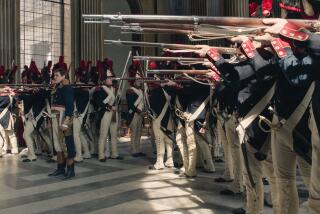Dreyer’s ‘Passion of Joan of Arc’ Showcases an Inspired Joan
Home Vision released three French films on video this week, ranging from a world classic to kitschy camp.
Carl Dreyer’s astonishing silent “The Passion of Joan of Arc” ($30), produced in 1928, is one of the greatest films ever made--a riveting, tragic retelling of the famed French martyr based on documentation from her original trial.
For the record:
12:00 a.m. Oct. 29, 1999 For The Record
Los Angeles Times Friday October 29, 1999 Home Edition Calendar Part F Page 2 Entertainment Desk 1 inches; 30 words Type of Material: Correction
‘Joan of Arc’--Maria Falconetti was the star of the 1928 film “The Passion of Joan of Arc,” which was released on home video this week. An article in Thursday’s Calendar Weekend identified her by the wrong first name.
Masterfully photographed by Rudolf Mate, who later directed films in Hollywood, the film features vivid, near-surreal close-ups of Joan and her inquisitors.
Renee Falconetti’s performance as Joan of Arc is unforgettable. She’s been cited by some critics as giving the greatest film performance of all time.
After the film’s initial release 71 years ago, the negative of “Joan of Arc” was destroyed by a fire. The director then put together a new version composed of its outtakes. Shortly thereafter, it also fell victim to a fire. In 1981, a near-perfect original cut was discovered in a janitor’s closet at a Norwegian mental institution. That film has been lovingly restored and remastered.
The Home Vision tape features Richard Einchorn’s haunting “Voices of Life,” an orchestral work inspired by the film.
On the other end of the spectrum is the 1956 sex comedy “Plucking the Daisy” ($20), starring Brigitte Bardot. This flimsy, silly farce finds Bardot playing a young woman named Agnes, who has written an anonymous and scandalous best-selling romance. When her father, a high-powered general in Vichy, discovers what she’s done, she runs away to Paris to find her brother, who she believes is a successful painter. Of course, he’s just a penniless guide at the Balzac museum. She finds time to fall in love with a handsome womanizing newspaper reporter (Daniel Grelin).
Through a series of absolutely unbelievable circumstances, Bardot ends up in a striptease contest. Seeing that her boyfriend is in the audience, she disguises herself with a wig and a mask and ends up winning the contest. There’s a smattering of nudity, which was probably considered daring in 1956. Roger Vadim, who directed Bardot that year in “And God Created Woman,” co-wrote the script.
Bardot is up to more sex-kitten antics in the 1958 Technicolor comedy “Une Parisienne” ($20). Digitally remastered and presented in a wide screen version, Bardot plays a pouty, spoiled daughter of the president of France who pursues and marries a handsome government official (Henri Vidal). But when she thinks her husband has strayed, she runs off to Nice with a prince (Charles Boyer).
More to Read
Only good movies
Get the Indie Focus newsletter, Mark Olsen's weekly guide to the world of cinema.
You may occasionally receive promotional content from the Los Angeles Times.











